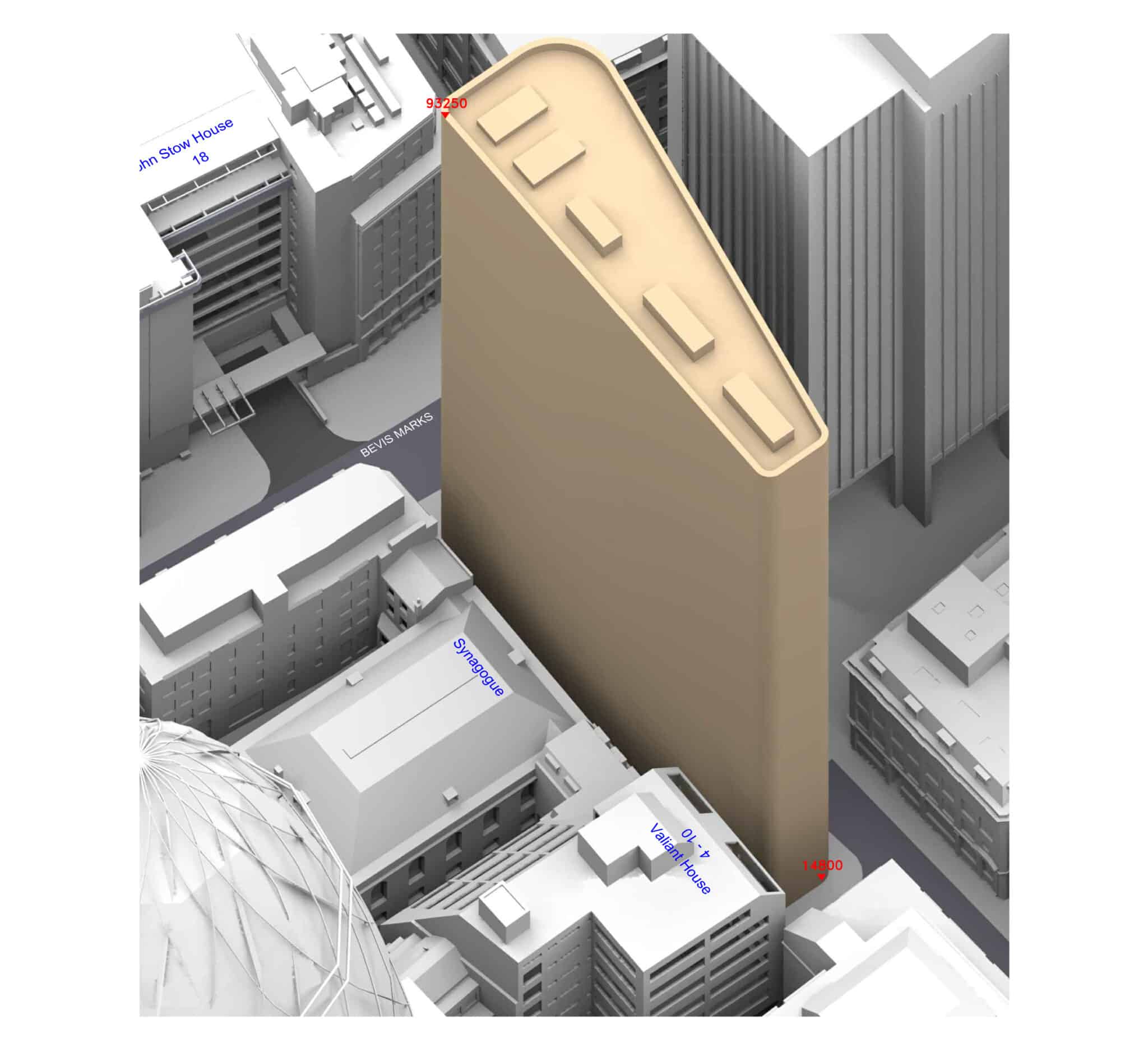Developers want to build a giant structure just metres from London’s historic Bevis Marks Synagogue

A ceremony at the Spanish and Portuguese Jews Congregation, at Bevis Marks Synagogue, London.
(C) Blake Ezra Photography 2015.
Developers are trying to build a giant 21-storey tower block just three metres from Bevis Marks Synagogue, London’s historic and world-famous Sephardi shul.
Jews with a connection to the iconic building now have less than two weeks to object, after a planning application was submitted for the glass-fronted retail and office block rising skywards just yards from the UK’s oldest synagogue.
Sephardi leaders in the UK said it would “tower over” the Grade I listed 300-year old building and are now “calling the community to action,” urging people to write and tell City of London planners what they think.
The planning application to demolish and replace a building that is currently the same height as the shul has been submitted by developers at Quod for 33 Creechurch Lane, the building adjacent to the synagogue.

Impression of what the new structure would look like. Bevis Marks is the middle building on the left
Early images show the effect it will have on light, the heritage environment and potentially the building’s structure, with the project’s Heritage, Townscape and Visual Impact Assessment (HTVIA) recognising the impact.
Under the Government’s own National Planning Policy Framework, published in July last year, the setting of a Heritage Asset such as Bevis Marks Synagogue is defined as “the surroundings in which a Heritage Asset is experienced… it is not fixed”.
The HTVIA consultants appeared to confirm the planned office’s detrimental impact on the synagogue, saying: “It is our view that the retention of a sense of intimacy and the interaction of small spaces with larger buildings are the principal characteristics which define the presence of the synagogue.”
They added: “Just as the synagogue forms part of the City’s historic grounding, so the City’s form helps to provide a sense of the synagogue’s historic significance.”
Consultants said the significance of the building is “drawn largely from its age, its rarity, and from some internal features which remain largely untouched, and some of which pre-date the structure itself”.
They added: “There is also substantial significance found in the communal value of the place of worship owing to its status as the oldest surviving synagogue in the UK.
“The contribution of setting is important, but must be viewed within the context of its limited overall scope, and the importance that can be derived from the contrast of old and new.”
London’s Mayor Sadiq Khan may be asked to get involved, because City Hall’s Consolidated London Plan (CLP) states that “the impact of tall buildings in sensitive locations should be given particular consideration,” adding that “such areas might include… listed buildings and their settings”.
Bevis Marks Synagogue, which opened in 1701, seven years before St Paul’s Cathedral, is regarded as the most beautiful synagogue in the country and is considered “home to the Sephardi Jewish community,” but this week Sephardi leaders said the new office plans were a huge threat.
“This is our synagogue and it’s for us to protect it for our future generations,” said leaders of the S&P Sephardi Community on Thursday. “We have been monitoring this and now we need your help.”
There is now very little time to register comments and concerns about developers’ plans for glass-facade office and retail block located within the Eastcheap and Bank Conservation Areas, because the deadline for doing so is Tuesday 12 February.
Designer Ben Eley sought to allay concerns, saying: “The siting, materials, design, and form would be harmonious with the age and architectural style of the host building and would preserve the character and appearance of the area and the setting of nearby heritage assets.”
However Bevis Marks trustees were far from convinced, saying: “We are deeply concerned over the major impact that the development would have on the historic setting of the Synagogue along with the reductions in daylight and sunlight into the Synagogue and the much used courtyard.
“This overbearing presence will change the much loved character and atmosphere of the Synagogue and its immediate surroundings. We are also worried about disturbance to our services, disabled access and damage to the Synagogue’s fabric during the construction of such a large tower so close to our 300 year old building.”
Annie Hampson, the City of London’s chief planning officer, acknowledged the potential impact on the synagogue in the public notice, stating that the proposed development “is considered to affect the setting of a Building of Special Architectural or Historical Interest”.
Apart from a few minor additions such as doors, seats and lighting, the building remains largely unchanged since it was first built, having since survived a fire in 1749, the London Blitz, an IRA bomb in 1992 and the Bishopsgate bombing in 1993.
But after being told of the plans in a letter dated 10 January, Historic England raised no objections, as evidenced by a redacted letter published on the City of London’s planning page online.
The organisation, whose strapline is “championing England’s heritage,” told the Corporation of London’s department of planning and transportation that “we do not wish to offer any comments,” adding: “It is not necessary for us to be consulted on this application again, unless there are material changes to the proposals.”
To ease traffic concerns from nearby residents, the Proposed Servicing Plan for the new building encourages deliveries in late evening and weekends, impacting shul-goers who attend on Friday nights and Saturdays for Shabbat services.
Source: Time of Israel January 31, 2019
 eSefarad Noticias del Mundo Sefaradi
eSefarad Noticias del Mundo Sefaradi

